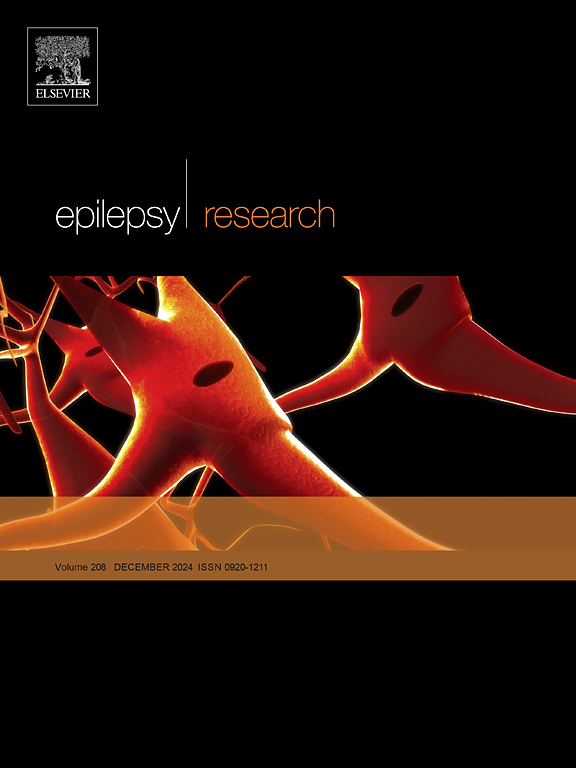Influence of executive functions on quality of life in Pediatric Epilepsy: A cross-sectional study
IF 2
4区 医学
Q3 CLINICAL NEUROLOGY
引用次数: 0
Abstract
Background
The EpiTrack Junior is a screening tool assessing executive function in children with epilepsy. This study aimed to investigate whether children and adolescents with epilepsy are at a higher risk of experiencing a reduced quality of life if they also reveal abnormal results reflecting executive dysfunction.
Methods
We screened patients for executive dysfunction using the clinical test tool EpiTrack Junior. To assess health-related quality of life (HRQoL), the German children’s and parents’ version of KINDL questionnaire was used. The KINDL scores (total score and dimensions scores) of patients with and without clinically conspicuous values were compared (≤ 28 and > 29, respectively). In addition, the exact EpiTrack Junior point scores were correlated with the KINDL total score and the scores of all KINDL dimensions.
Results
In this study 112 (mean age = 11.72, SD = 3.6) patients with epilepsy and their parents were included. Patients with executive dysfunctions (EpiTrack Junior values ≤ 28) scored significantly poorer in the QoL categories ‘family’ and ‘social environment’ than patients without. In the ‘family’ dimension, the child-report revealed the following data: z = -2.759; adjusted p-value: 0.042, and in the ‘friends’ dimension, parent-reports yielded the following data: z = -3.645; adjusted p-value: 0.007. In contrast, the 'self-esteem' dimension in the children's version showed significantly higher values in patients with executive dysfunctions than for those without: z = -2.524; adjusted p-value: 0.042. No significant differences between patients with and without executive dysfunctions were found for the overall quality of life (as assessed by the KINDL 'total score') as well as for the other dimensions (school, physical and emotional well-being).
Conclusions
No differences were found in the overall quality of life between patients with and without executive dysfunction. Nevertheless, executive dysfunction appeared to have a negative impact on some areas of life, such as family and friends, and was a predictor of increased self-esteem.
执行功能对儿童癫痫患者生活质量的影响:一项横断面研究
背景:EpiTrack Junior是一种评估癫痫儿童执行功能的筛查工具。本研究旨在调查儿童和青少年癫痫患者是否有更高的风险经历生活质量下降,如果他们也显示异常结果反映执行功能障碍。方法使用临床测试工具EpiTrack Junior筛选执行功能障碍患者。为了评估与健康相关的生活质量(HRQoL),使用了德国儿童和家长版的KINDL问卷。比较有和无临床显著值患者的KINDL评分(总分和维度评分)(分别≤28分和>; 29分)。此外,准确的EpiTrack Junior点得分与KINDL总分和KINDL各维度得分呈正相关。结果本研究共纳入112例癫痫患者及其父母,平均年龄11.72岁,SD = 3.6。执行功能障碍患者(EpiTrack Junior值≤28)在生活质量类别“家庭”和“社会环境”方面的得分明显低于无执行功能障碍患者。在“家庭”维度,儿童报告揭示了以下数据:z = -2.759;调整p值:0.042,在“朋友”维度,父母报告得出以下数据:z = -3.645;调整p值:0.007。相比之下,儿童版本的“自尊”维度在执行功能障碍患者中显示出显著高于无执行功能障碍患者的值:z = -2.524;调整p值:0.042。在有和没有执行功能障碍的患者之间,没有发现总体生活质量(由KINDL“总分”评估)以及其他方面(学校、身体和情感健康)的显著差异。结论执行功能障碍患者与非执行功能障碍患者的总体生活质量无差异。然而,执行功能障碍似乎对生活的某些领域有负面影响,比如家庭和朋友,并且是自尊增强的一个预测指标。
本文章由计算机程序翻译,如有差异,请以英文原文为准。
求助全文
约1分钟内获得全文
求助全文
来源期刊

Epilepsy Research
医学-临床神经学
CiteScore
0.10
自引率
4.50%
发文量
143
审稿时长
62 days
期刊介绍:
Epilepsy Research provides for publication of high quality articles in both basic and clinical epilepsy research, with a special emphasis on translational research that ultimately relates to epilepsy as a human condition. The journal is intended to provide a forum for reporting the best and most rigorous epilepsy research from all disciplines ranging from biophysics and molecular biology to epidemiological and psychosocial research. As such the journal will publish original papers relevant to epilepsy from any scientific discipline and also studies of a multidisciplinary nature. Clinical and experimental research papers adopting fresh conceptual approaches to the study of epilepsy and its treatment are encouraged. The overriding criteria for publication are novelty, significant clinical or experimental relevance, and interest to a multidisciplinary audience in the broad arena of epilepsy. Review articles focused on any topic of epilepsy research will also be considered, but only if they present an exceptionally clear synthesis of current knowledge and future directions of a research area, based on a critical assessment of the available data or on hypotheses that are likely to stimulate more critical thinking and further advances in an area of epilepsy research.
 求助内容:
求助内容: 应助结果提醒方式:
应助结果提醒方式:


